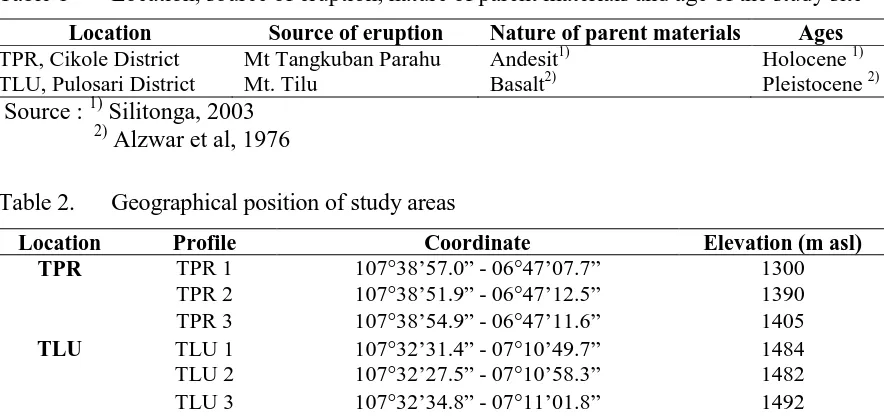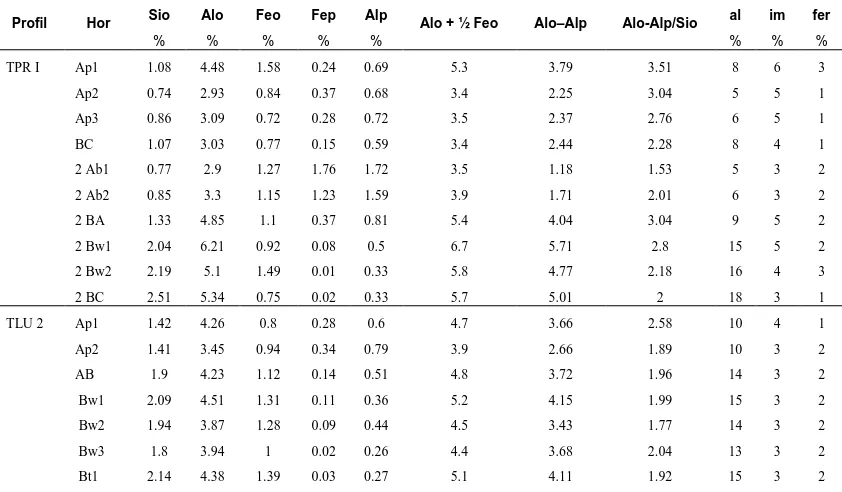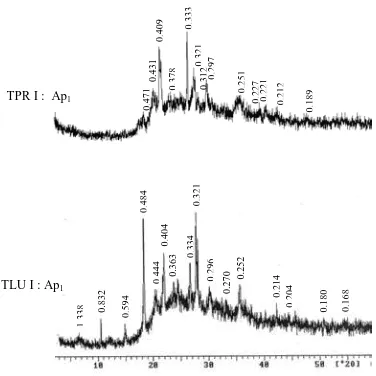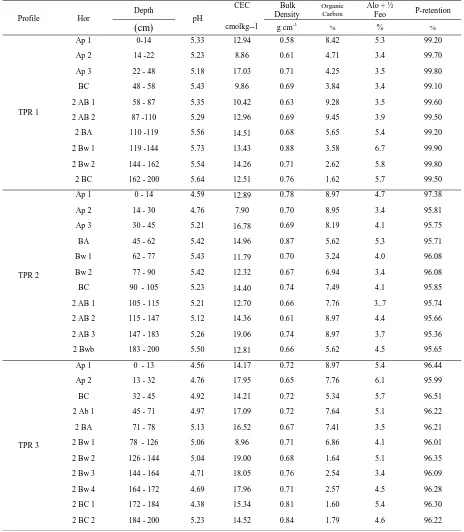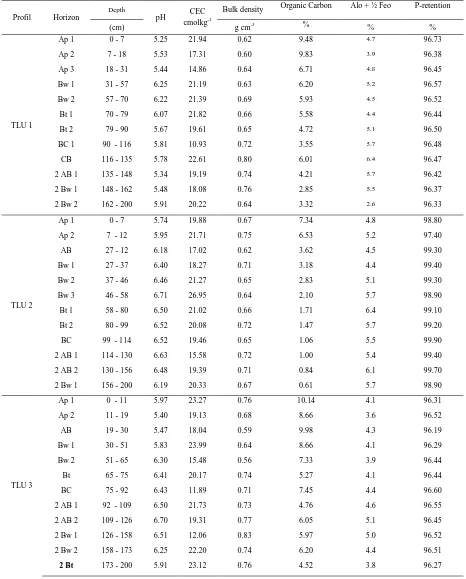Soils Developed on Volcanic Materials in West Java, Indonesia
Rina Devnita, Padjadjaran University, Indonesia Mahfud Arifin, Padjadjaran University, Indonesia E. Hidayat Salim, Padjadjaran University, Indonesia Adjat Sudradjat, Padjadjaran University, Indonesia Ridha Hudaya, Padjadjaran University, Indonesia Eric Van Ranst. Ghent University, Belgium
Abstract: Six profiles developed on volcanic materials were selected in West Java, Indonesia.
Three profiles derived on andesit parent material from Holocene age, and three others derived on basalt parent material from Pleistocene age. The soils were described and analyzed for having the morphological, mineralogical, chemical and physical characteristics. Fieldwork and laboratory analyses were done, include the analyses with acid oxalate, phyrophosphate and X-Ray Diffractometer. The results showed that the soils developed on andesit parent materials have the lower pH and CEC than the soils developed on basalt parent material. Soils derived from Holocene age have different mineralogical composition than soils derived from Pleistocene age. However, all soils have C-organic lower than 20 %, bulk density lower than 0.9 g cm-3, P-retention higher than 85 %, and Al and Fe (extracted with acid oxalate) higher than 2 % and therefore, fulfilled the requirements for andic soil properties, and be classified as Andisols.
Keywords: andic, Andisol, andesit, basalt, Holocene, Pleistocene
Introduction
Mountains of volcanic origins are rather widespread in West Java Province, Indonesia. Out from the 129 active volcanoes in the whole territory of Indonesia, 18 volcanoes are located in West Java (Sudradjat, 2009). Therefore, soils derived from volcanic materials are found in the volcanoes vicinities for example around Mt. Tangkuban Parahu and Mt. Tilu (Arifin, 1994).
Volcanic soils have unique and distinct physical properties encourage plant growth, such as low bulk density (Broquen et al, 2005), high water retention, high organic matter content (Yuan et al, 2000), high permeability and stable structure (Hoyos & Comerford, 2005) and provide an important area for agriculture, especially for tea plantation and horticulture. However, soils derived from volcanic materials are characterized by the abundance of short range order minerals assemblage dominated by allophane, imogolite and ferrihydrite (Van Ranst, 2008). These minerals are defined as variable charge minerals and the soils charge therefore are largely dependent on the pH and electrolyte concentration of the soil solution (Uehara & Gillman, 1981). The variable charge soils have high pH0 and low cation
Mineralogical and chemical analyses of volcanic soils indicated that their mineral
composition varies depending on the stage of soil formation, the horizon, the nature of parent materials, the thickness of overburden ash deposits and probably other factors. The
formation and transformation of clay minerals by weathering of volcanic materials are also affected by accumulation of humus which forms complexes with Al and Fe and with some clay minerals.
Volcanic soils in West Java are varies due to the natural of parent materials and ages. Soils derived from Mt. Tangkuban Parahu are andesit origin from Holocene age (Silitonga, 2003), meanwhile soils derived from Mt. Tilu are basalt origin from Pleistocene age (Alzwar et al, 1976). Soils from different the natural parent materials and ages were described for macromorphological features and analyzed for their mineralogical, chemical and physical characteristics.
State of the Art
The main reasons for investigating the mineralogical, chemical and physical characteristics of these soils are: (1) to assess the profile homogeneity (2) to evaluate the degree of weathering, and (3) to classify the soil.
Literature Review
The unique properties of volcanic soils influenced by volcanic parent materials, result from active solid phase of active Al and Fe, which consist of allophane, imogolite and ferrihydrite or Al/Fe humus complexes often together with opaline silica. These two groups have an inverse relationship, because the two groups have the opposing conditions favoring their formation (Parfit & Kimble, 1989). Metal-humus complexes are dominant at pH values less than 5, while allophane and imogolite are dominant at higher pH values. Another common constituent in many volcanic soils displaying a wide range of structural disorder halloysite. Halloysite is found as the dominant clay mineral in Si-rich environment, while Al-rich allophane and imogolite are found at comparatively lower Si concentration. Volcanic soils in Indonesia could also contain quartz, cristobalite, trydimite, feldspar, gibbsite, goethite, hematite, mica, and some other layer silicate minerals (Syarif, 1990; Utami, 1998; Fiantis, 2004).
The composition of parent material strongly affects the formation clay minerals in volcanic soils. Higher proportions of volcanic glass in basaltic material result in the formation of more allophane and imogolite than more andesitic parent materials (Mizota, 1981). Volcanic soils containing 2:1 and 2:1:1 layer silicates are derived from quart-rich parent materials, while gibbsite and allophane dominate in soils from andesitic ashes that do not contain quartz. Some studies of volcanic soils in Indonesia indicated that there was no systematic differences between the noncrystalline and crystalline mineral composition from different parent
relationship between parent materials and sand mineralogical composition (Sutanto, 1988; Syarif, 1990).
The age of parent materials and the development stage of the soils also affected the clay mineral compositions. In tropical areas, allophane predominates in the clay fraction of young volcanic soils (Bleeker & Parfitt, 1974). With increasing age, allophane is replaced by halloysite and gibbsite. However, young soils may be dominated by smectite, vermiculite, chorite intergrade and opaline silica. The allophane content and its SiO2/Al2O3 molar ratio
tend to increase with age (Shoji & Saigusa, 1977). Some studies indicated that the effect of age is still confusing.
Volcanic soils exhibit distinctive physical properties which distinguish them from other soils like low bulk density, high 1.5 MPa water content, high water content at field capacity, high liquid limit and low plasticity index, problem in dispersion, and irreversible changes in physical properties in drying (Maeda et al, 1984). These characteristics are attributable directly to the properties of the parent material, the short range order constituents formed by weathering, and soil organic matter accumulated during soil formation (Nanzyo et al, 1993, Bartoli, 2004).
The low bulk density of volcanic soils is attributable to the development of highly porous soils structure. The low bulk density and the unique consistence greatly contribute to the easy tillage of volcanic soils. Volcanic soils also show the low degree of stickiness, plasticity and hardness that result from the abundance of short-range order minerals and organic matter. It is possible to till these soils even when soil water content is lower than the shrinkage limit and somewhat higher than the plastic limit. Volcanic soils also have a well developed soil structure resulting in high porosity with a range of pore size that retains a large amount of water. These physical properties provide an excellent environment for root growth (Nanzyo et al, 1993)
The noncrystalline constituents of volcanic soils have been shown to have a strong influence on chemical behaviour of these soils. The studies indicate that the common chemical
characteristics of volcanic soils are high of organic matter content (Van Ranst, 1991), high phosphate retention (Van Ranst et al., 1993), and high pH0 (Qafoku et al, 2004). These soils
naturally have high basic cations released from the weathering of parent materials as far as the CEC of the soils can be maintained high for preventing the loses of the cations through leaching and percolating (Uehara & Gilman. 1981).
Material and Method
Study areas
samples and profile descriptions were taken from the eastern upper slope, namely as TLU 1, TLU 2 and TLU 3.
The soil profiles from both volcanoe are located under the pine forest vegetation (Figure 1). The forest vegetations were chose for minimizing the anthropogenic influence to the soils development. All profiles were made in the slope of 8 – 15 % for minimizing the influence of erosion to the horizonation of the soils. Historically, the eruptions of both volcanoes have occurred intermittently over the years varying from flank vents to eruption of mostly
moderate in sizes.
(a) (b)
Figure 1. Vegetation and Landuse of Mt. Tangkuban Parahu (a) and Mt. Tilu (b)
Table 1 shows the location, nature of the parent material and age of the study areas, meanwhile Table 2 shows the coordinate number and the elevation of the soil profiles.
Table 1 Location, source of eruption, nature of parent materials and age of the study site
Location Source of eruption Nature of parent materials Ages
TPR, Cikole District Mt Tangkuban Parahu Andesit1) Holocene
TLU, Pulosari District
1)
Mt. Tilu Basalt2) Pleistocene
Source :
2)
1)
Silitonga, 2003
2)
Table 2. Geographical position of study areas Alzwar et al, 1976
Location Profile Coordinate Elevation (m asl)
TPR TPR 1 107°38’57.0” - 06°47’07.7” 1300
TPR 2 107°38’51.9” - 06°47’12.5” 1390
TPR 3 107°38’54.9” - 06°47’11.6” 1405
TLU TLU 1 107°32’31.4” - 07°10’49.7” 1484
TLU 2 107°32’27.5” - 07°10’58.3” 1482
TLU 3 107°32’34.8” - 07°11’01.8” 1492
In the field, the profiles were described guided by National Soil Survey Center / NSSC (2004). Laboratory analyses are minerals in sand fraction with polarizing microscope, clay mineralogy with XRD, P-retention (Blakemore et al, 1987), pH H2O and pH KCl (glass
pyrophosphate (Blakemore, 1987), pH0 (Gillman & Abel, 1986), bulk density, CEC
(ammonium acetate, pH 7) and follow the Van Reeuwijk (1992). The analyses of clay mineralogy with XRD, P-retention, organic carbon, pH2O, pH KCl and pH0, extractable Fe,
Al, and Si with acid oxalate and phyrophosphate were done in the Laboratory of Soil Science in Ghent University, Belgium. The rest of analyses were done in the Laboratory of Soil Chemistry and Soil Physic, Faculty of Agriculture, Padjadjaran University, Indonesia.
Result and Discussion
Soil Morphology
Morphological characteristics of volcanic soils focused on the in situ description supported with the laboratory analyses. Soil horizon indicate that there were lithologic discontinue, marked by the presence of A buried horizon (2 Ab) below the C or BC horizon. These are the indication that the soil derived not only from one period of erosion but at least from two periods of eruptions.
The depths of the overlying buried horizons are different between TPR and TLU profiles. In TPR, the depth is less than 100 cm, while in TLU the depth is more than 100 cm. This is one of indication that the TPR (Holocene) profiles are thinner and younger than TLU
(Pleistocene).
B horizons were found in all profiles, indicated that all soils have developed enough to form an elluvial horizon. However, the B horizons in TPR were still quite similar with C horizons (Ap-BC-CB-C), while the B horizon in TLU have far more developed, indicated by the formation of Bw and Bt horizons (Ap-Bw-Bt-BC-CB).
The soils have the medium texture due to the high content of sand and silt fractions. The textures therefore, are in the range of silt, silty loam and silty clay loam. TPR profile
(Holocene) dominated by silt and silty loam texture, while TLU profile (Pleistocene) have the higher clay indicated by the silt, silty loam up to silty clay loam texture.
The composition of sand fraction
The parent material of the soils of Mt. Tangkuban Parahu are tuff of sand with the coarse hornblend crystall and weathered reddish lahar in andesit composition from the eruption of Mt. Dano dan Mt. Tangkuban Parahu (Van Bemmelen, 1949) of Holocene age symbolized by Qyd in the geological map of Silitonga (2003).
The parent material of soils of Mt. Tilu are from old volcanoe of tuff, breccia, lahar with a few of pumice and lava in basalt composition from the eruption of Mt. Tilu of Pleistocene age, symbolized with Qtl in the geological map of Alzwar et al (1976).
Table 3. Mineral composition of the sand fraction of the represented profile and horizon in TPR and TLU
Profil Heavy Minerals/HM % Light Minerals/LM % Total
%
NCVG = Non coloured volcanic glass CVG = Coloured volcanic glass Fel = Feldspar
Qua = Quartz RF = Rock fragment
The quantitative of mineralogical analyses of the clay fraction
Table 4. The quantitativeof mineralogical analyses of the clay fraction
Profil Hor Sio Alo Feo Fep Alp Alo + ½ Feo Alo–Alp Alo-Alp/Sio al im fer
Sio = Si extracted by acid oxalate Alo = extracted by acid oxalate Feo = extracted by acid oxalate Fep = Fe extracted by phyrophosphate Alp = extracted by phyrophosphate
All = allophane Imm = immogolite Fer = ferryhidrite
Qualitatitive mineralogical analyses with XRD
The XRD analyses indicated that the soils have the quite similar reflection consist of feldspar (0.376, 0.363, 0.321, 0.315 nm), crystoballite (0.405, 0.252 nm), gibbsite (0.485, 0.438 nm), ferrihydrite (0.212, 0.195 nm) and quartz (0.425, 0.334 0. 245, 0.228, 0.181, 0.154 nm). These reflections can be seen in the Figure 2.
Figure 2. The reflection of profile TPR and TLU
Figure 3. The reflection of mineral 1:1 and 2:1 after the treatment of oxalate, and the saturation of Mg, Mg+glycol and heated at 350 0C dan 550 0C of TLU profile
Figure 4. The change of reflection after the treatments of TPR profile
1.
338
0.
424 0.404
1.338
0.
424
0.
404
1.362
0.
714
0.484
0.
444
0.
404
Ap1 Ap2 Ap3
0.
424
0.
714
1.338 1.420
The chemical and physical characteristics
The chemical characteristics of the soils are presented in Table 5 and 6.
Table 5. The chemical and physical characteristics of the profiles TPR
Table 6. The chemical and physical characteristics of profiles TLU
derived from andesit parent materials which have the lower pH than basalt parent materials. The values CEC are followed by the value of the CEC, where the soils derived from andesit parent materials have lower CEC than the soils derived from basaltic parent material. As the soils with variable charge, besides be influenced by the parent materials, the values of CEC are depending on the value of the soil pH. The lower the pH give the lower CEC as well, and vice versa.
Another data on the Table 5 and 6 inform about the organic carbon, bulk density, Al and Fe extracted by acid oxalate (Alo + ½ Feo), and P retention. These data are required for an indication of the presence of andic soil properties of these soils. Andic soil properties are the properties involved with the soils derived from volcanic parent materials. Having the andic soil properties, the soils must have bulk density less than 0.9 gcm-3
The soil classifications to the lower categories (family) are presented in Table 7.
, organic carbon less than 20 %, Alo + ½ Feo more than 2 % and P-retenion more than 85 %. The soils in TPR and TLU which developed from the different nature of parent materials and ages, however, fullfiled all the requirements for andic soil properties, and therefore, can be classified as Andisols (Soil Survey Staff, 2010).
Table 7. Soil classification refer to Soil Survey Staff, 2010.
Profile Classification
TPR 1 Typic Hapludand, medial, amorph, isohyperthermic
TPR 2 Typic Hapludand, medial, amorph, isohyperthermic
TPR 3 Typic Hapludand, medial, amorph, isohyperthermic
TLU 1 Ultic Fulvudand, medial, amorph, isohyperthermic
TLU 2 Ultic Hapludand, medial, amorph, isohyperthermic
TLU 3 Ultic Fulvudand, medial, amorph, isohyperthermic
Conclusions
The soils developed on volcanic materials in West Java, Indonesia showed the difference in the morphological, mineralogical, physical and chemical composition related to their parent materials and ages. However, all of the soils fulfilled the requirements of andic soil properties and therefore, can be classified as Andisols.
Acknowledgments
References
Alzwar, M., Akbar, N., and Bachri, S. (1976). Geological Map of Garut Pamengpeuk, West Java, Geological Research and Development Centre. Indonesia
Arifin, M. (1994). Pedogenetic of Andisols Derived from Andesit and Basalt Volcanic Ash in Some Agroclimatic Zones of Tea Plantation in West Java. Ph.D. Thesis. Bogor Institute of Agriculture. 202 p (in Indonesian).
Bartoli, F. (2004). Shrinkage and Drainage in Undisturbed Soil Cores and Aggregates from A Range of European Volcanic Soils. Volcanic Soils Resources in Europe. Cost Action 622 final meeting. Rala Report. 214:49-50
Blakemore, L. C., Searle, P.L., and Daly, B.K. (1987). Methods for Chemical Analysis of Soils. N. Z. Soil Bureau Sci. Rep. 80. Soil Bureau. Lower Hutt, New Zealand.
Bleeker, P., and Parfitt, R.L. (1974). Volcanic ash and its clay mineralogy at Cape Hopkins, New Britain, Papua New Guinea. Geoderma, vol. 11:123-135
Broquen, P., Lobartini, J. C., Candan, F., and Falbo, G. (2005). Allophane, aluminum, and organic matter accumulation across a bioclimatic sequence of volcanic ash soils of Argentina. Geoderma, vol. 129, 167-177. E-Journal on-line. Retrieve 1st
Fiantis, D. (2000). Colloid-surface caharacteristics and amelioration problems of some volcanic soils in West Sumatera, Indonesia. Ph.D. Thesis. University Putra Malaysia. Serdang. Selangor. Malaysia. 270 p.
of September, 2006 from http://www.elsevier.com/locate/geoderma
Hoyos, N., and Comerford, N. B. (2005). Land use and landscape effects on aggregate stability and total carbon of andisols from Colombian Andes. Geoderma, vol. 129, 268-278. E-Journal on-line. Retrieve 1st
Maeda, T., Takenaka, H., and Warkentin, B.P. (1984). Physical properties of allophanic soils. Adv. Agron., vol. 29, 229-264.
of October 2006 from http://www.elsevier.com/locate/geoderma
Mizota, C. (1981). Clay mineralogy of seven Dystrandepts developed from basalt in Northland, the French massive central, and western Oregon. Soil Sci. Plant Nutr., vol 27, 511-522.
Nanzyo, M., Shoji, S., and Dahlgren, R. A. (1993). Physical Characteristics of Volcanic Ash Soils. In: Shoji, S., Nanzyo, M., and Dahlgren, R. (Eds). Volcanic Ash Soil –
Genesis, Properties and Utilization. Elsevier, Amsterdam. p. 145-188.
Parfitt, R. L., and Kimble, J. M. (1989). Conditions for formation of allophane in soils. Soil Science Society of American Journal, vol. 53, 971 – 977.
Qafoku, N. P., Van Ranst, E. Noble, A., and Baert, G. (2004). Variable charge soils, their mineralogy, chemistry and management. Advances in Agronomy, vol. 84, 157-213.
Shoji, S., and Saigusa, M. (1977). Amorphous clay materials of Towada Ando soils. Soil Sci. Plant Nutr., vol. 23, 437-455
Silitonga, P. H. (2003). Geological Map of Bandung, West Java. Geological Research and Development Centre. Indonesia
Soil Survey Staff. (2010). Keys to Soil Taxonomy. 11th
Sudradjat, A. (2009). The Development of Volcanologic Investigation in Indonesia. Universitas Padjadjaran Press. Bandung. Indonesia. 239 p.
ed. Natural Resources Conservation Service. 332 p.
Sutanto, R. (1988). Mineralogy, Charge properties and Classification of Soils on Volcanic Materials and Limestone in Central Java, Indonesia. Ph.D. Thesis. University of Ghent. Belgium. 233 p.
Syarif, S. (1990). Some characteristics of Andisol from Western Indonesia. Ph.D. thesis. University of Western Australia. 247 p.
Uehara, G., and G. Gillman. 1981. The Mineralogy, Chemistry And Physics of Tropical Soils with Variable Charge Clays. Westview Press, Inc. Colorado. 170 p.
Utami, S. R. (1998). Properties and Rational Management Aspects of Volcanic Ash Soils from Java, Indonesia. Ph.D. Thesis. University of Ghent. Belgium. 388 p.
Van Bemmelen, R. W. (1949). The Geology of Indonesia. Vol. I A : General Geology of Indonesia and Adjacent Archipelagoes. The Hague. Jakarta. 732 p.
Van Ranst, E. (1991). Soils of the Tropics and Subtropics : Geography, Classification, Properties and Management. Ghent University. Belgium. 293 p.
Van Ranst, E., Utami, S. R., Verdoodt, A., and Qafoku, N. P. (2008). Mineralogy of perudic Andosol in Central Java, Indonesia. Geoderma, vol. 144, 379-386.
Van Ranst, E., De Conninck, F. and Debaveye, J. (1993). Implication of Charge Properties and Chemical Management of Volcanic Ash Soils in West Cameroon. Proceeding In 2nd
Van Reeuwijk, L. P. (1992). Procedure for Soil Analysis. 4 African Soil Science Society Conference, p. 255-264.
th
Yuan, G., Theng, B. K. G., Parfit, R. L., and Percival, H. (2000). Interaction of allophane with humic acid and cations. European Journal of Soil Science, vol. 51, 35-41.
